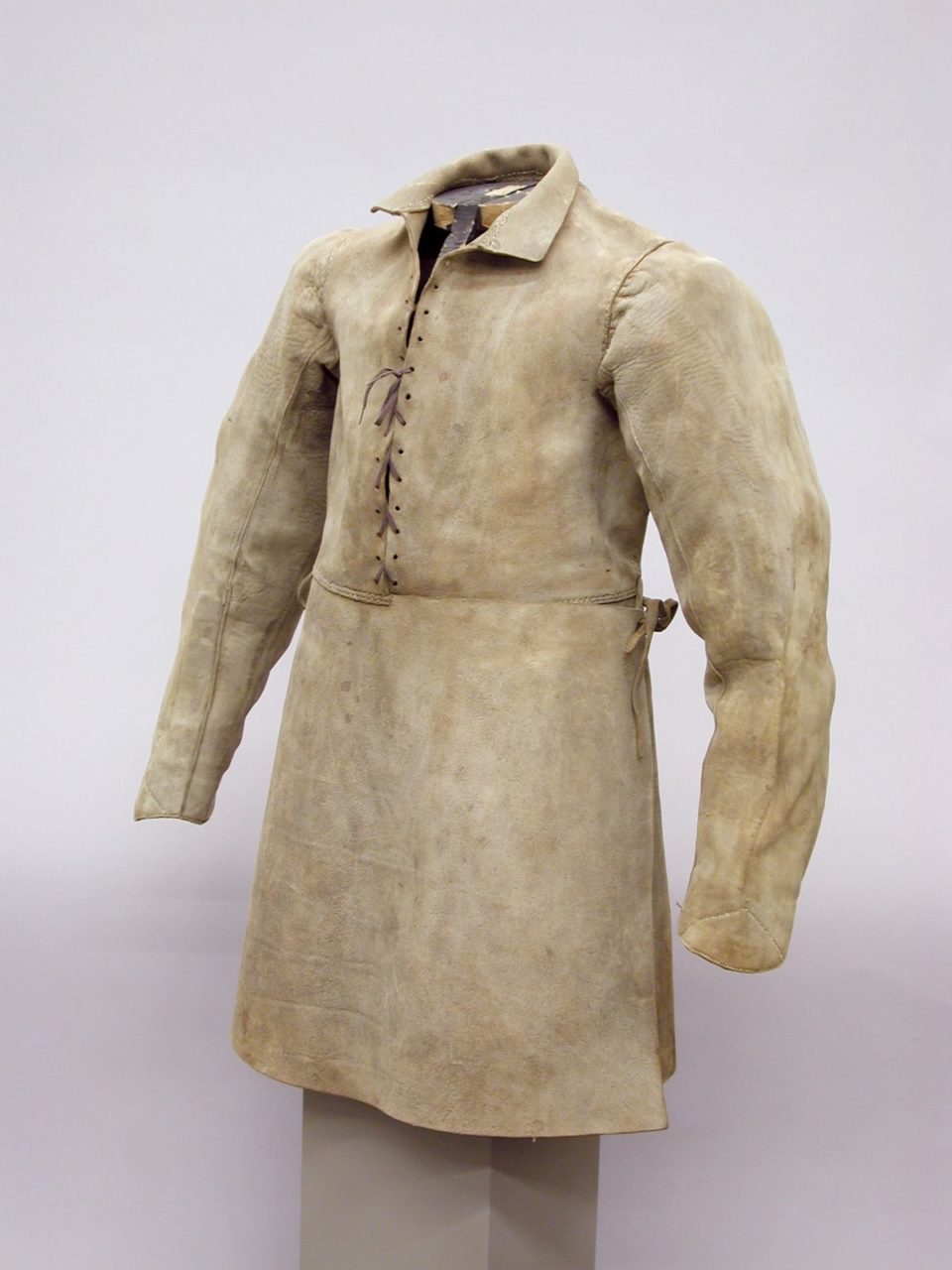A leather version of the doublet that was often, but not exclusively, worn by people in the military in the 17th century.
The Details
Daniel Delis Hill defines the buff coat in his History of World Costume and Fashion (2011):
“An outerwear leather version of the doublet was called a buff coat. The name comes from the color of the soft buckskin used to make the coat. Designs varied, including long-sleeve and sleeveless vest-like sleeveless versions and separate bodice and skirt constructions. Slits were made in the skirt at the back front and sides for ease of horseback riding. Most buff coats were unembellished although some portraits of the time depict an edging of colorful embroidery or ribbon trim of the bodice closure accented with a wide border of scarlet shag.” (399-400)
You can see an example of a buff coat in figure 1, which is held by the Metropolitan Museum in New York City.
Clothing and Fashion: American from Head to Toe (2015) discusses the buff coat further:
“So while the buff coat is generally considered a type of military garment, its design reflected the prevailing civilian styles. The majority of the surviving buff coats were designed with a relatively high waist with flared four-panel skirts that extended over the breeches to the thighs. Buff coats were designed to utilize the tough leather hide to its full protective advantage. The thickest parts of the hide were generally placed at the bottom of the coat to protect the legs while riding.” (42)
Another example can be seen at the National Army Museum in London, as shown in figure 2.
Marieke de Winkel describes the buff coat in Fashion and Fancy: Dress and Meaning in Rembrandt’s Paintings (2006):
“The buff coat was a protective garment made of thick oxhide and and was used by professional soldiers as well as by members of the civic militia. Usually sleeveless, it was worn over a doublet often with gold embroidered sleeves and a sash.” (108)
In figure 3 you can see another buff coat from the Royal Armouries Collection in England.
Francis Michael Kelly writes about the buff coat in European Costume and Fashion (2002) when discussing 17th-century fashion:
“The military jerkin (or buff coat) with very deep skirts spreading and overlapping is widely adopted. It is generally laced together or tied with points in front, and when without leather sleeves may be provided with sleeves of stuff- in which case a doublet beneath becomes unnecessary. The sleeves, whether of doublet or jerkin, are in military circles frequently striped or braided round. In the ‘forties the buff-coat grows short and skirtless.” (124)
The Royal Armouries Collection has another buff coat with sleeves that was laced up the front (Fig. 4), as was typical. This buff coat in particular was used by harquebusiers, the most common form of cavalry in Europe during the 17th century.
Fig. 1 - Designer unknown (European). Buff coat, 17th century. Leather, string laces; 88.9 cm (35 in). New York: Met Museum, 29.158.885. Bashford Dean Memorial Collection, Funds from various donors, 1929. Source: MET Museum
Fig. 2 - Designer unknown. Buff Coat, 17th century. Leather. London: National Army Museum, 1972-09-49-1. Source: National Army Museum
Fig. 3 - Designer unknown (England, 1643). Buff Coat, 17th century. Leather, string laces; height 85.0 cm, width 48.0 cm, neck to waist 37.0 cm, skirt length 38.0 cm, (height 33.5 in, width 18.9 in, neck to waist 14.6 in, skirt length 14.9 in,). England: Royal Armouries Collection, III.4593. Source: Royal Armouries Collection
Fig. 4 - Designer unknown (England, 1631-1670). Buff Coat, 17th century. Leather, string laces; height 95.5 cm, width at armpit 48.0 cm, width at hem 94.0 cm, width at each skirt 55.5 cm, sleeve, outside length 58.0 cm (height 37.7 in , width at armpit 18.9 in , width at hem 37.1 in , width at each skirt 21.9 in, sleeve, outside length 22.9 in). England: Royal Armouries Collection, III.1926. Source: Royal Armouries Collection
References:
-
F, José Blanco, Patricia Kay Hunt-Hurst, Heather Vaughan Lee, and Mary Doering. Clothing and Fashion: American Fashion from Head to Toe. Vol. 4. ABC-CLIO, 2015. http://www.worldcat.org/oclc/1020777281.
-
Hill, Daniel Delis. History of World Costume and Fashion. Upper Saddle River, N.J: Pearson Prentice Hall, 2011. http://www.worldcat.org/oclc/939043732.
-
Kelly, Francis Michael, and Randolph Schwabe. European Costume and Fashion, 1490-1790. Mineola, New York: Courier Corporation, 2002. http://www.worldcat.org/oclc/925810687.
- Winkel, Marieke de. Fashion and Fancy: Dress and Meaning in Rembrandt’s Paintings. Amsterdam: Amsterdam University Press, 2006. http://www.worldcat.org/oclc/925810687.













